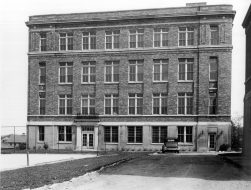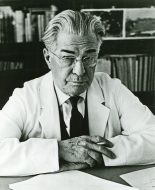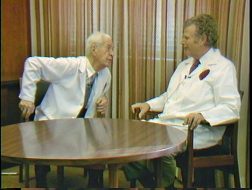Recently, Smithsonian.com published a brief article on the history of leaded

Dr. Robert Kehoe, Kettering Laboratory, UC, date unknown
gas. The article, seen here, http://www.smithsonianmag.com/smart-news/leaded-gas-poison-invented-180961368/, is informative though by no means exhaustive. The story begins in 1920, 55 miles up I-75, in Dayton, Ohio, at the General Motors Research Corporation. An engineer there, Thomas Midgely, and his boss, Charles F. Kettering, had developed an anti-engine knock additive called TEL or tetraethyllead.
At the time, “engine knock,” which was due to a malfunction between the fuel, air, and ignition explosion in a car’s cylinder, was at best a mild annoyance causing a light knocking sound and at worst a problem capable of destroying an automobile engine. Midgely’s solution was to add TEL to gasoline which would raise the combustability, or octane, of an engine lessening its chances of malfunctioning.
It worked. Which was all well and good, but TEL contained lead, and as people have known for ages, lead isn’t particularly good for us. In fact it’s rather deadly. The author goes on to discuss the outcry that erupted after several workers died after being exposed to TEL on a regular basis. A federal study was authorized in 1925 and it was decided that the amount of risk associated to every day exposure for most people was minimal and the production of leaded gasoline continued. It was not until the 1970s that growing evidence over leaded gas’s danger became evident. In January, 1996, the U.S. Clean Air act, officially banned the sale of leaded fuel for use in vehicles.
So why is the Winkler Center for the History of the Health Professions so interested in this Smithsonian.com article? The answer to that is really found in what we feel is the large portion of the story the author, for completely understandable reasons, was unable to include. That story belongs to Dr. Robert A. Kehoe.
The Winkler is the proud keeper of the Robert A. Kehoe Archives, 150 cubic feet of materials documenting the life and career of the collection’s namesake. It was Robert Kehoe’s advocacy for TEL in the late 1920s that helped Charles F. Kettering’s Ethyl Corporation continue the production of leaded gasoline. Kehoe believed that presence of lead in humans and other organisms was normal and that exposure to low lead levels was not harmful.
Robert A. Kehoe was a 1920 graduate of the University of Cincinnati College of Medicine, who, as a toxicologist, would become a leader in occupational health and the preeminent medical proponent of the use of tetraethyllead as an additive in gasoline.
While an instructor in the UC Department of Physiology in 1924, he was hired by Charles Kettering for General Motors to examine health issues related to tetraethyllead’s production. In 1925, Kehoe became the chief medical advisor of the Ethyl Corporation.

Kettering Lab, c. 1930
In 1930, a new laboratory funded by the General Motors, Ethyl, and DuPont corporations, the Kettering Laboratory of Applied Physiology, opened at UC with Kehoe as its first director. It was the first of its kind, i.e., the first university-based laboratory devoted to the toxicological problems peculiar to industry.
Kehoe’s theories and the famous “Kehoe Paradigm” helped to define the limits to industrial responsibility for lead pollution and poisoning for decades. He was convinced of the idea that manufacturers and distributors of industry could self-regulate rather than being restrained by legislation as it related to environmental control.

In retrospect, it might be easy for some to view the career of Robert Kehoe as an apologist for big business. The Winkler Center’s Kehoe Collection however sheds light on a research-based physician firmly convinced of his scientific findings. It also shows a career not only devoted to the defense of leaded gasoline’s use, but also one that insisted lead be kept out of children’s toys. And finally, Kehoe’s career was one which shaped, and stressed, the development of industrial safety and public health in the United States, especially as it relates to occupational health protection.

Oral history interview done with Dr. Kehoe. To view the oral history simply click on the image and download the interview.
I’m sure the author of the Smithsonian piece had an article word-limit as well as other parameters which made talking about Kehoe an impossibility, but there may have been other factors. Currently the Kehoe Collection remains unprocessed. For an archive, the Smithsonian article drives home the importance of making collections accessible and open to the research public. Had the Kehoe Collection been properly processed and available for research, it’s quite possible his name would have entered the story. The Winkler Center is currently seeking funding to arrange, digitize, and make accessible the Robert A. Kehoe Collection. Even in its current state, the collection is an invaluable one. Once processed, its academic research possibilities will be rife. We look forward to providing this resource to those studying business, medicine, occupational health and a variety of other subjects.
Works Used
Kehoe, R. A. “Occupational medicine and public health.” Public Health Reports. 1961
Kitman, J. “The Secret History of Lead.” The Nation. 17 August 2009.
Wikipedia contributors, “Robert A. Kehoe,” Wikipedia, The Free Encyclopedia, https://en.wikipedia.org/w/index.php?title=Robert_A._Kehoe&oldid=745119252 (December 15, 2016).
